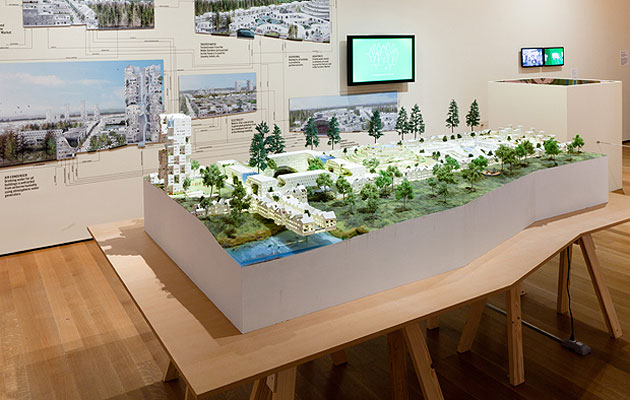|
|
||
|
A new show at MoMA takes the foreclosure crisis as the starting point for imagining an alternative, but not necessarily better, future for America’s suburbs. Here’s our review In 1774, the Declaration of Colonial Rights declared that the colonists of North America had the immutable right to enjoy “life, liberty and property”. Two years later this document was reworked into the Declaration of Independence, and man’s immutable rights were tinkered with in order to replace “property” with “the pursuit of happiness”. Yet while “property” was struck from the record its spirit lingered on: owning a house became a key component of the fantasy of upward social mobility that we now know as the American Dream.This dream of property ownership never seemed more attainable than in the first decade of the 21st Century, when lax regulation, cheap credit and financial speculation led to a building boom and subsequent bust. The mass of foreclosures, particularly in suburban areas, prompted this show at MOMA. It attempts not only to provide alternative ideas to property ownership and suburban design, but also seeks to change the desire to own property that lies at the heart of the American Dream. Five teams of architects, economists, engineers, lawyers, landscape designers and other specialists have worked on a selection of troubled suburban sites across the country to produce “an array of visions” of a new way of living. They are responding to the Buell Hypothesis, a long and somewhat loopy text in the form of a Socratic dialogue, put forward by the Buell Center at Columbia University whose aim is to “change the dream” of property ownership in America. Its maxims are perverse but enjoyable and often hit the mark. “The private house,” it states, “[is] just as institutionalized within social and economic policy as a public housing complex”. MOS suggests a “radical urbanism” as the way to transform the depressed suburb of The Oranges, New Jersey. All the town’s roads would be built upon, with the new buildings flooding the suburb’s main arterial routes in an attempt to revive a diseased community. Old abandoned houses would sit next to the new and a massive solid urban space would replace cookie-cutter suburbia. Even more radically, MOS states that the new properties in their designs would not be individually owned but that residents would have “portable mortgages” which would allow the local residents to “participate directly in determining the qualities of their neighbourhood”. This sort of vague, non-ideological collectivism hangs over the entire show. Designs by Visible Weather and, in particular, Zago Architecture, stress the blurring of the usual lines between public and private, renting and owning, residential and commercial sites. Such imprecise boundaries give these projects a Ballardian air: what use is changing the dream if you replace it with a nightmare? The main problem with the show was that the architects involved seem torn between providing sweeping visionary gestures and wanting to offer immediate answers to an immediate problem. Those who chose the latter path offer solutions that are, if anything, more dispiriting than the quasi-dystopic views of their colleagues. Studio Gang Architects’ repurposing of an old freight railway station in Cicero, Illinois into differing housing typologies where “informal entrepreneurial businesses” would flourish seems a purely urban solution paying little attention to a suburb’s innate characteristics. After all, the problem the suburbs face is not a lack of housing but a surfeit of it. Foreclosed seems less an attempt to save the suburbs than a chance to put them out of their misery for good. Foreclosed: Rehousing the American Dream is at The Museum of Modern Art, New York until 30 July |
Words George Pendle |
|
|
||


















